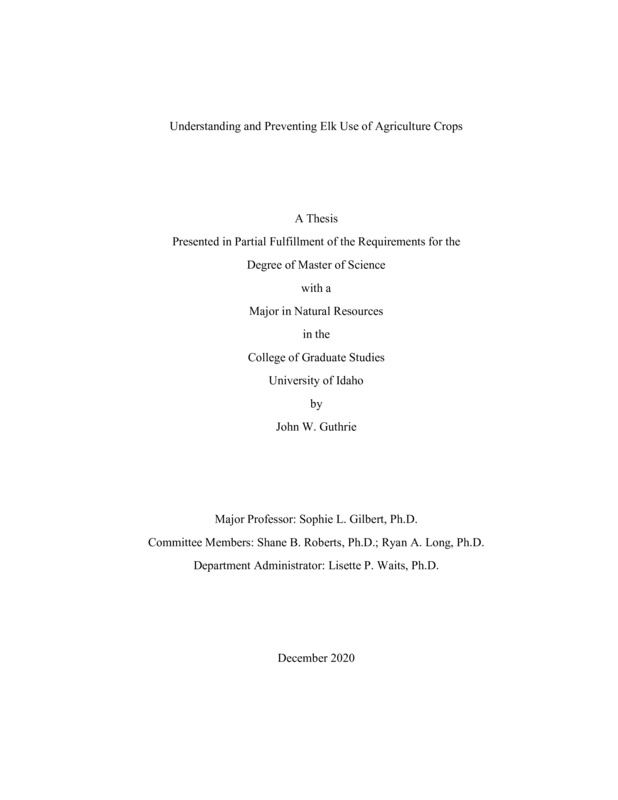Understanding and Preventing Elk Use of Agriculture Crops
Guthrie, John. (2020-12). Understanding and Preventing Elk Use of Agriculture Crops. Theses and Dissertations Collection, University of Idaho Library Digital Collections. https://www.lib.uidaho.edu/digital/etd/items/guthrie_idaho_0089n_12010.html
- Title:
- Understanding and Preventing Elk Use of Agriculture Crops
- Author:
- Guthrie, John
- Date:
- 2020-12
- Keywords:
- Agriculture Depredation Elk
- Program:
- Natural Resources
- Subject Category:
- Wildlife management
- Abstract:
-
Since the early 1900s, elk (Cervus canadensis nelsoni) populations throughout much of the Rocky Mountain west have expanded in size and geographic range. Simultaneously, humans and agriculture production have encroached into natural elk habitat, and human-elk conflicts have arisen, most notably between elk and agriculture producers. With expanding elk populations and increasing elk-caused damages to agriculture, there remains many unresolved questions regarding: 1) the mechanisms that influence habitat selection patterns of elk in an agriculture-dominated landscape, and 2) effective deterrent treatments designed to reduce elk use of agriculture crops. To address this need, we analyzed habitat selection patterns of elk using high-frequency location data from GPS-collared elk (n = 67), which were captured in areas with high levels of elk use in agriculture throughout southern Idaho. We also tested the efficacy of two behavior-modifying deterrents, which included: 1) targeted lethal removal of elk (non-collared) actively utilizing agriculture fields; and 2) pasture fence modification with electrified wire to exclude elk from crops. We used logistic regression with the interactive effects of agriculture and time to evaluate how changes in agriculture crop phenology influence habitat selection. To evaluate the effectiveness of our targeted lethal removal deterrent treatment, we compared habitat selection patterns of GPS-collared treatment (e.g., elk treated with sharpshooting) and control elk at the summer home-range (i.e., 3rd order selection) and movement-step (i.e., 4th order selection) scale to quantify the effect of sharpshooting. We used observation survey and camera trap data to evaluate the effectiveness of our pasture fence modification treatment. We found that elk selected for areas that provided security from predators and thermal cover during the day, while foraging habitats, primarily in the form of agriculture, were selected for during the night. A strong relationship was observed between plant phenology and agriculture use with an increase in agriculture selection occurring through the growing season. Variation in life history strategies of elk emerged in our analyses, relative to the proportional use and availability of agriculture in elk home ranges. This variation in life history strategies suggest that elk can live in agriculture landscapes without relying on agriculture as a primary food source. We found that at both spatial scales, elk treated with targeted lethal removal reduced their selection of treatment fields where such treatments occurred, and movement-step scale results showed that elk treated with targeted lethal removal avoided all agriculture in general more than control elk. Our pasture fence modification treatment reduced elk use of treatment fields, but results across treatment sites varied. We found that as time since constructing the modified pasture fence increased, more elk crossed into the treatment fields. For both deterrents tested, we found they were most effective in areas where elk densities were low and alternative agriculture food sources were abundant.
- Description:
- masters, M.S., Natural Resources -- University of Idaho - College of Graduate Studies, 2020-12
- Major Professor:
- Gilbert, Sophie L
- Committee:
- Roberts, Shane B; Long, Ryan A
- Defense Date:
- 2020-12
- Identifier:
- Guthrie_idaho_0089N_12010
- Type:
- Text
- Format Original:
- Format:
- application/pdf
- Rights:
- In Copyright - Educational Use Permitted. For more information, please contact University of Idaho Library Special Collections and Archives Department at libspec@uidaho.edu.
- Standardized Rights:
- http://rightsstatements.org/vocab/InC-EDU/1.0/

